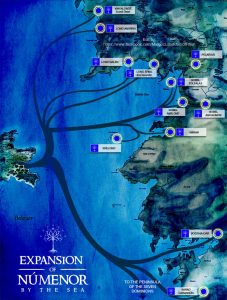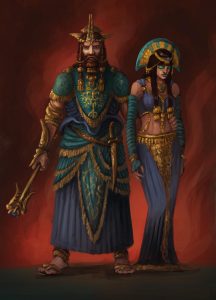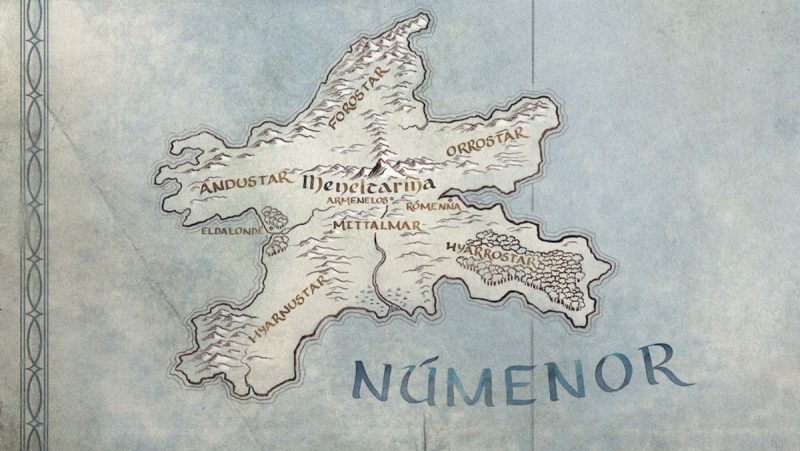Tar-Minastir, who halted Sauron’s armies, decided to establish settlements in the region to prevent possible new attacks in Middle-earth and stationed Numenorean soldiers in these settlements. However, Tar-Minastir’s constructive idea marked the beginning of an unstoppable change in Numenor. The Numenoreans, who had proven their strength to themselves and everyone else, had their confidence boosted and embarked on the path of power corruption. Tar-Ciryatan, who succeeded Tar-Minastir, initiated the first colonization in 1869, questioning why they were only settling in some regions, suggesting they spread everywhere. This colonization also paved the way for taxation. The Numenoreans, who established settlements in different territories of Arda, began taxing the races in the areas they settled.

Tar-Ciryatan was also the first emperor to question the Valar. Although the Valar had granted Numenor to the Edain, they had one condition: never to travel to Aman. Valar, who said they could travel to the east as they wished, prohibited them from going west. When Tar-Ciryatan questioned both the travel ban to the West and why the Elves were special, Valar sent a representative to tell them that Arda was created for the Elves, but when the time came, everyone had a place in Mandos’ halls. However, Ciryatan was not satisfied with this explanation because in Aman, being immortal was just a journey, while in a world they enjoyed, they could be immortal and live it.
Tar-Ciryatan was the first name to initiate the change in Numenor. His son, Tar-Atanamir, continued this understanding. However, the sharp change in Numenor began during the reign of Tar-Ancalimon. Most of the population living in Numenor was on the verge of breaking away from Eru and the Elves. A group called the King’s Men, primarily consisting of the king and his family, lost faith in the Valar and Eru, while a group known as the Faithful, led by the Lord of Andunie, remained faithful to Eru and the Elves.
After Tar-Ancalimon, the throne passed to Tar-Telemmaite and then to his daughter, Tar-Vanimelde. With Vanimelde’s death, the throne went to her spouse, Tar-Anducal. Tar-Anducal was never considered an official king. Therefore, the next ruler after Vanimelde was her son, Tar-Alcarin. After Tar-Alcarin, his son Tar-Calmacil ascended the throne. Calmacil was the first king to change his name, using Ar-Belzagar in the Adunaic language instead of Tar-Calmacil in the Quenya language. After Ardamin, Tar-Herunumen took the throne and ruled directly under the Adunaic name Ar-Adunakhor, which meant Lord of the West and directly referred to Manwe.
The estrangement of Numenor from the Valar was accelerating under the rule of the kings. The Valar had severed communication with those who did not believe in them and maintained contact only with the faithful. Following the reigns of Ar-Zimrathon and Ar-Sakalthor, Ar-Gimilzor, who came to power, banned the use of any language other than Adunaic in Numenor and began to spy on Andunie with spies. Learning that the people of Andunie were in contact with the Elves of Tol Eressea, the king expelled all the inhabitants of Andunie to Romenna. Following this event, many people left Numenor and settled in Middle-earth.

Ar-Gimilzor had refused to perform the traditional ceremony of ascending to Meneltarma Mountain for the sake of honoring Eru, and he disregarded the Nimloth tree in the royal gardens. Gimilzor had married a woman of great beauty named Inzilbeth, but Inzilbeth was among the believers in Eru. Gimilzor had two children; his firstborn, Inziladun, shared his mother’s belief in Eru and the Valar. However, his second son, Gimilkhad, was like his father. Nevertheless, Gimilzor, unable to change the laws, passed the throne to his son Inziladun, who believed in the Valar.
Inziladun waged war against the corruption that had taken hold in Numenor. First, a return to the use of Quenya names was initiated. Inziladun’s name became Tar-Palantir. Palantir began to take an interest in Nimloth again and also ascended Meneltarma Mountain to demonstrate his loyalty to Eru. However, the corruption was so deep that it was beyond Palantir’s power to resolve. Consequently, an internal turmoil began in Numenor. Palantir’s brother, Gimilkhad, raised the banner of rebellion. Palantir awaited a message from the Valar throughout his reign, but that message never came.
Palantir had a daughter named Tar-Miriel. After him, Miriel was supposed to ascend the throne, and she, like her father, believed in Eru and the Valar. However, there was no trust for Miriel among the people. Corruption had grown so pervasive that the faithful had become outcasts. Recognizing this, Ar-Pharazon, playing a dangerous game using the power of his name, coerced Miriel into marrying him. Thus, the throne was forcibly taken from Miriel, who had faith in the Valar. The throne passed to perhaps the most ambitious emperor in Numenor’s history. However, his ambition would mark the beginning of the end for Numenor.
Sources and Further Information
- Tolkien, J.R.R & Tolkien, Christopher. “The Silmarillion,” Houghton Mifflin Company (2004)
- Tolkien, J.R.R & İpek, Çiğdem Erkal “Translator”. “Yüzüklerin Efendisi,” Metis Yayınları (2007)
- Tolkien, J.R.R & Tolkien, Christopher. “The Children of Húrin,” HarperCollins (2007)
- Tolkien, J.R.R & Tolkien, Christopher. “Beren and Lúthien,” Houghton Mifflin Harcourt (2017)
- Tolkien, J.R.R & Tolkien, Christopher. “The Fall of Gondolin,” Houghton Mifflin Harcourt (2018)
- Orta Dünya – Legendarium Türkiye, YouTube
- Yüzüklerin Efendisi – Orta Dünya, YouTube
- Nerd of the Rings, YouTube
